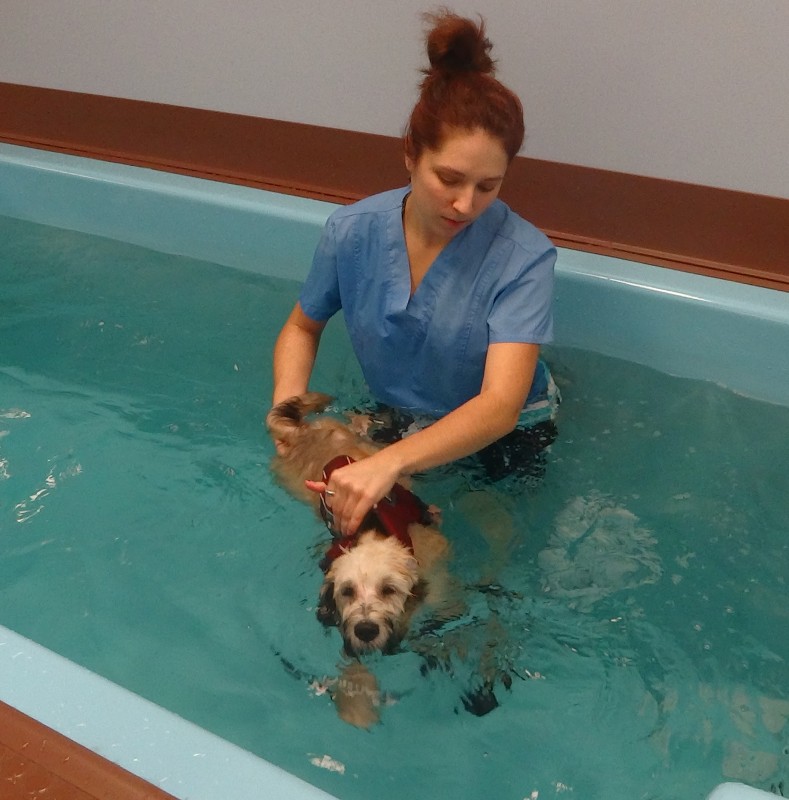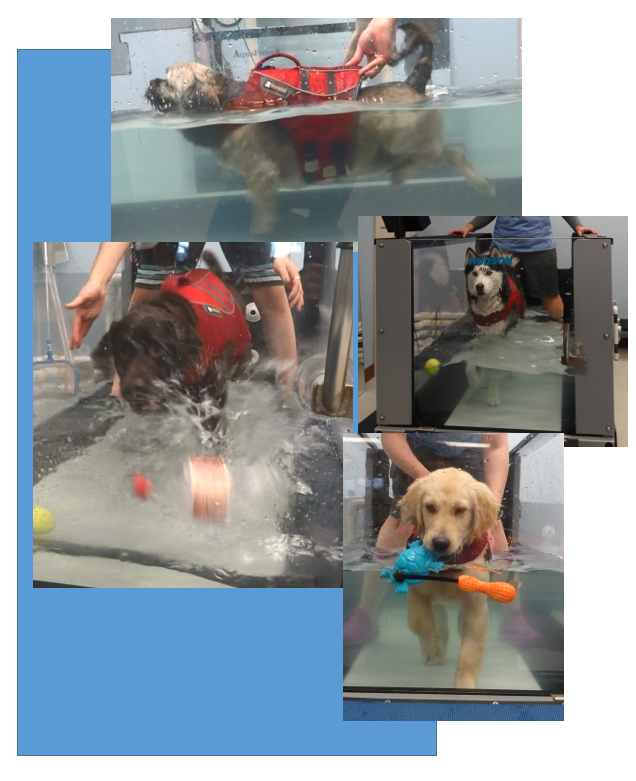Hydrotherapy: Swimming or Underwater Treadmill?
By: Colleen Lum, LVT, CCRA
When is it more appropriate to choose the underwater treadmill instead of swimming? Swimming is just as good as walking in water right? Not the case. Although both activities involve the use of water, they differ in how they benefit our patients and the type of patients they treat more effectively. How do we choose between swimming or underwater treadmill?
Both of these methods of hydrotherapy use the properties of water to aide in the rehabilitation process. Water offers the following abilities:
- Resistance (pulling limbs through and out of the water helps strengthen atrophied/weakened muscles)

- Buoyancy (support for weak patients and lessens the impact gravity has on arthritic/degenerative joints)
- Controlled temperature (warmth to help soothe joints and muscles and improve circulation)
- Hydrostatic pressure (pressure that water places on the body that helps circulatory problems and decrease swelling/edema)
Underwater Treadmill
Patient variables (primary complaint, age, etc.) are taken into consideration when deciding on which modality would be the most beneficial for their treatment plan. About 95% of our patients use the underwater treadmill because it is a more balanced option than swimming. The majority of those patients are dogs with osteoarthritis in multiple joints, those recovering from orthopedic surgery, or managing a neurologic disease (i.e. degenerative myelopathy).
Advantages of Underwater Treadmill Use
- Extension of the limbs/joints is more complete than with swimming
- Control of how fast the patient moves
- Control of how much weight the patient bears as they are moving (height of water)
- More balanced treatment for patients with multiple issues (multiple joints, muscle atrophy, etc.)
- Support for weak patients (able to move better in water than on land)
- Less intimidating than swimming for patients who are fearful of water (with our treadmill, water fills slowly from the bottom)
- Gentle and low impact enough for post-surgical patients (2 weeks post op with sutures removed)
Disadvantages of Underwater Treadmill Use
- Some patients are fearful of the belt moving under their feet and will refuse to walk
- Walking on a moving belt in the water requires the patient to have some degree of coordination or body awareness which can be very challenging for seniors or severe neurologic patients
Swimming
As active as swimming is, it is not always the best option for therapeutic treatment. Surprisingly, some dogs do not like water and will panic or fight when faced with it, especially if we are trying to walk them into an open pool. We all know swimming can be beneficial for cardiovascular health. However, patients need to have a strong core to keep their body level and afloat which most of our family pets and even athletic companions do not possess. Swimming also takes weight completely off of their limbs, which is good for arthritis but not helpful for patients who are reluctant to use the limb (i.e. post operative TPLO patients, etc.).
Advantages of Swimming
- Flexion of the joints is greater when swimming than walking in the water
- Swimming renders the patient completely non-weight bearing which removes all concussive forces on their joints
- Great for core strength
- Improves cardiovascular strength
- Patients with front limb nerve injuries often times use the limb during swimming before they will place the limb to walk
- Neurological patients who are unable to stand and support themselves will sometimes swim before they walk because the buoyancy of the water makes them “weightless”
Disadvantages of Swimming
- Swimming benefits flexion of joints more but is not as effective for improving extension
- Not a good option for patients who are unfit (seniors/geriatrics, weak core/stamina, etc.)
- More intimidating for patients who are fearful or do not like water
- Minimal control of the patient’s movement
- Dogs do not generally use their hind limbs effectively when swimming (they use primarily forelimb movement)
- Contraindicated in early post-surgical patients
So in the case of which modality is more effective, it really boils down to our goals as rehab professionals and patient ability when determining the proper method. Aquatherapy, whether it be swimming or submerged walking, can be very beneficial in the rehabilitation process for many patients. The fun part is figuring out which path to take.

References
Daryl L. Millis, D. L. (2014). Canine Rehabilitation and Physical Therapy. Philadelphia: Elsevier Saunders.
Read more about hydrotherapy at our website here.
